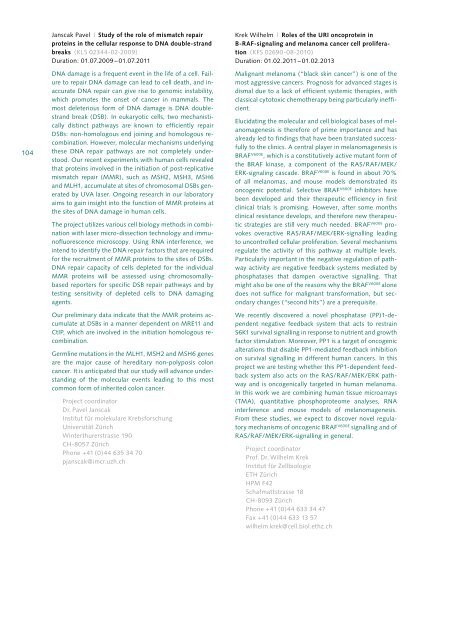Cancer Research in Switzerland - Krebsliga Schweiz
Cancer Research in Switzerland - Krebsliga Schweiz
Cancer Research in Switzerland - Krebsliga Schweiz
You also want an ePaper? Increase the reach of your titles
YUMPU automatically turns print PDFs into web optimized ePapers that Google loves.
104<br />
Janscak Pavel | Study of the role of mismatch repair<br />
prote<strong>in</strong>s <strong>in</strong> the cellular response to DNA double-strand<br />
breaks (KLS 02344022009)<br />
Duration: 01.07.2009 – 01.07.2011<br />
DNA damage is a frequent event <strong>in</strong> the life of a cell. Failure<br />
to repair DNA damage can lead to cell death, and <strong>in</strong>accurate<br />
DNA repair can give rise to genomic <strong>in</strong>stability,<br />
which promotes the onset of cancer <strong>in</strong> mammals. The<br />
most deleterious form of DNA damage is DNA doublestrand<br />
break (DSB). In eukaryotic cells, two mechanistically<br />
dist<strong>in</strong>ct pathways are known to efficiently repair<br />
DSBs: nonhomologous end jo<strong>in</strong><strong>in</strong>g and homologous recomb<strong>in</strong>ation.<br />
However, molecular mechanisms underly<strong>in</strong>g<br />
these DNA repair pathways are not completely understood.<br />
Our recent experiments with human cells revealed<br />
that prote<strong>in</strong>s <strong>in</strong>volved <strong>in</strong> the <strong>in</strong>itiation of postreplicative<br />
mismatch repair (MMR), such as MSH2, MSH3, MSH6<br />
and MLH1, accumulate at sites of chromosomal DSBs generated<br />
by UVA laser. Ongo<strong>in</strong>g research <strong>in</strong> our laboratory<br />
aims to ga<strong>in</strong> <strong>in</strong>sight <strong>in</strong>to the function of MMR prote<strong>in</strong>s at<br />
the sites of DNA damage <strong>in</strong> human cells.<br />
The project utilizes various cell biology methods <strong>in</strong> comb<strong>in</strong>ation<br />
with laser microdissection technology and immunofluorescence<br />
microscopy. Us<strong>in</strong>g RNA <strong>in</strong>terference, we<br />
<strong>in</strong>tend to identify the DNA repair factors that are required<br />
for the recruitment of MMR prote<strong>in</strong>s to the sites of DSBs.<br />
DNA repair capacity of cells depleted for the <strong>in</strong>dividual<br />
MMR prote<strong>in</strong>s will be assessed us<strong>in</strong>g chromosomallybased<br />
reporters for specific DSB repair pathways and by<br />
test<strong>in</strong>g sensitivity of depleted cells to DNA damag<strong>in</strong>g<br />
agents.<br />
Our prelim<strong>in</strong>ary data <strong>in</strong>dicate that the MMR prote<strong>in</strong>s accumulate<br />
at DSBs <strong>in</strong> a manner dependent on MRE11 and<br />
CtIP, which are <strong>in</strong>volved <strong>in</strong> the <strong>in</strong>itiation homologous recomb<strong>in</strong>ation.<br />
Germl<strong>in</strong>e mutations <strong>in</strong> the MLH1, MSH2 and MSH6 genes<br />
are the major cause of hereditary nonpolyposis colon<br />
cancer. It is anticipated that our study will advance understand<strong>in</strong>g<br />
of the molecular events lead<strong>in</strong>g to this most<br />
common form of <strong>in</strong>herited colon cancer.<br />
Project coord<strong>in</strong>ator<br />
Dr. Pavel Janscak<br />
Institut für molekulare Krebsforschung<br />
Universität Zürich<br />
W<strong>in</strong>terthurerstrasse 190<br />
CH8057 Zürich<br />
Phone +41 (0)44 635 34 70<br />
pjanscak@imcr.uzh.ch<br />
Krek Wilhelm | Roles of the URI oncoprote<strong>in</strong> <strong>in</strong><br />
B-RAF-signal<strong>in</strong>g and melanoma cancer cell proliferation<br />
(KFS 02690082010)<br />
Duration: 01.02.2011 – 01.02.2013<br />
Malignant melanoma (“black sk<strong>in</strong> cancer”) is one of the<br />
most aggressive cancers. Prognosis for advanced stages is<br />
dismal due to a lack of efficient systemic therapies, with<br />
classical cytotoxic chemotherapy be<strong>in</strong>g particularly <strong>in</strong>efficient.<br />
Elucidat<strong>in</strong>g the molecular and cell biological bases of melanomagenesis<br />
is therefore of prime importance and has<br />
already led to f<strong>in</strong>d<strong>in</strong>gs that have been translated successfully<br />
to the cl<strong>in</strong>ics. A central player <strong>in</strong> melanomagenesis is<br />
BRAF V600E , which is a constitutively active mutant form of<br />
the BRAF k<strong>in</strong>ase, a component of the RAS/RAF/MEK/<br />
ERKsignal<strong>in</strong>g cascade. BRAF V600E is found <strong>in</strong> about 70 %<br />
of all melanomas, and mouse models demonstrated its<br />
oncogenic potential. Selective BRAF V600E <strong>in</strong>hibitors have<br />
been developed and their therapeutic efficiency <strong>in</strong> first<br />
cl<strong>in</strong>ical trials is promis<strong>in</strong>g. However, after some months<br />
cl<strong>in</strong>ical resistance develops, and therefore new therapeutic<br />
strategies are still very much needed. BRAF V600E provokes<br />
overactive RAS/RAF/MEK/ERKsignall<strong>in</strong>g lead<strong>in</strong>g<br />
to un con trolled cellular proliferation. Several mechanisms<br />
regulate the activity of this pathway at multiple levels.<br />
Particularly important <strong>in</strong> the negative regulation of pathway<br />
activity are negative feedback systems mediated by<br />
phosphatases that dampen overactive signall<strong>in</strong>g. That<br />
might also be one of the reasons why the BRAF V600E alone<br />
does not suffice for malignant transformation, but secondary<br />
changes (“second hits”) are a prerequisite.<br />
We recently discovered a novel phosphatase (PP)1dependent<br />
negative feedback system that acts to restra<strong>in</strong><br />
S6K1 survival signall<strong>in</strong>g <strong>in</strong> response to nutrient and growth<br />
factor stimulation. Moreover, PP1 is a target of oncogenic<br />
alterations that disable PP1mediated feedback <strong>in</strong>hibition<br />
on survival signall<strong>in</strong>g <strong>in</strong> different human cancers. In this<br />
project we are test<strong>in</strong>g whether this PP1dependent feedback<br />
system also acts on the RAS/RAF/MEK/ERK pathway<br />
and is oncogenically targeted <strong>in</strong> human melanoma.<br />
In this work we are comb<strong>in</strong><strong>in</strong>g human tissue microarrays<br />
(TMA), quantitative phosphoproteome analyses, RNA<br />
<strong>in</strong>terference and mouse models of melanomagenesis.<br />
From these studies, we expect to discover novel regulatory<br />
mechanisms of oncogenic BRAF V600E signall<strong>in</strong>g and of<br />
RAS/RAF/MEK/ERKsignall<strong>in</strong>g <strong>in</strong> general.<br />
Project coord<strong>in</strong>ator<br />
Prof. Dr. Wilhelm Krek<br />
Institut für Zellbiologie<br />
ETH Zürich<br />
HPM F42<br />
Schafmattstrasse 18<br />
CH8093 Zürich<br />
Phone +41 (0)44 633 34 47<br />
Fax +41 (0)44 633 13 57<br />
wilhelm.krek@cell.biol.ethz.ch

















